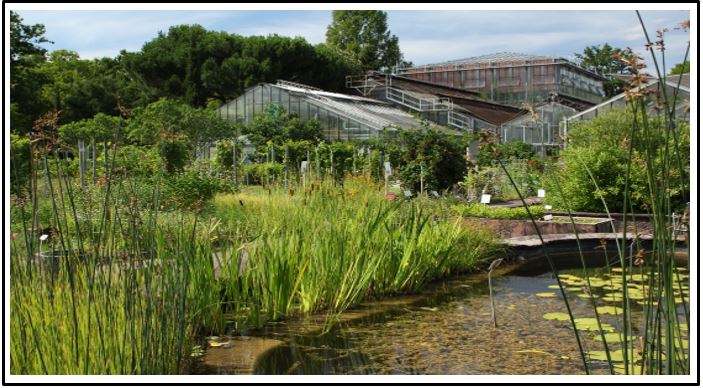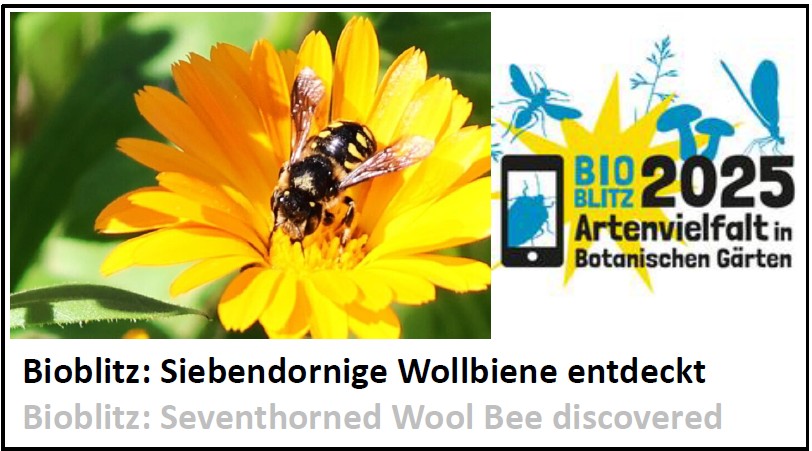Teilnehmerzahl ist begrenzt! Buchung
 |
Joseph-Gottlieb Kölreuter Institute for Plant Sciences
April-September Mo-Fr 8-16, So 10-16, October-March Mo-Fr 8-15, So 10-14, entrance free! How to find us
|
||
 |
Upcoming eventDr. Beatrix Zaban: In der Weihnachtsbäckerei: Von Zucker und Zimt, Vanille über Pistazie und Zitronat. Sonntag, 21.12.2025, 10-11:15. Ort: Botanischer Garten
Wissenswertes und Kurioses zum Staunen und Schmunzeln, welche Pflanzen die Basis unserer Lieblingsgebäcke und Aromen in der Weihnachtszeit ausmachen. |
||
 |
The Garden as Biodiversity-HotspotBiodiversity is at stake, especially in cities. Refugia of diversity are vital, therefore, to prevent extinction. Due to its nature, the Botanical Garden assembles a great diversity of plant species on small areas. This creates very diverse, small, ecosystems that are attractive for further life forms. At iNaturalist, a civil society movement to document biodiversity, the Botanical Garden again and again emerges as true biodiversity hotspot in Karlsruhe. This became recently clear again in the course of the Do-it-yourself activity BioBlitz, where, upon request of the Association of Botanical Gardens, dedicated citizens, organised by the Association of the Garden Friends documented and compiled nature observations. more... The highlight was a spectacular sight of the Seventhorned Wool Bee, a wild bee species at the verge of extinction. This observation demonstrates again that the Botanical Garden is also a precious refugium for numerous species of animals, plants, and fungi that have become rare. |
||
 |
Research News
Climate changes makes sea levels rise making fertile coastal land salty. The Nile delta, Bangladesh, Vietnam, but also the South of Italy are already today confronted with salt stress. Can we find crop plants that are able to thrive on such soils? In the past, we have, initiated by our Syrian colleague Dr. Adnan Kanbar, focused on stress resilience in Sorghum Millet. This ancient crop originates from Sudan and can cope with harsh conditions. In fact, we were able to show that some Sorghum varieties not only can grow under salinity, but accumulate more sugar when confronted with salinity. What happens to this sugar, differs - some Sorghum varieties store it in the shoot, what is interesting for bio-economic use (for instance for the production of bio-ethanol) others store it in their seeds, what supports food security in regions affected by soil salinity. During her PhD our colleague Eman Abuslima from Egypt was able to uncover the reason for the different sugar use: a gene switch for the sugar transporter SWEET13 decides. A very active version of this switch could be identified in the old Syrian landrace Razinieh. By breeding, this switch can now be crossed into other millet varieties, and by means of the molecular knowledge, the promising individuals in the progeny can be recognised already in the seedling stage by a simple PCR. Publication 216. Abuslima E, Kanbar A, Ismail A, Raorane ML, Eiche E, El-Sharkawy I, Junker BH, Riemann M, Nick P (2025) Salt stress-induced remodeling of sugar transport: a role for promoter alleles of SWEET13. Nature Sci Rep 15, 7580 - pdf
|
||
 |
Plant of the Month: Milk OrangeWhen you turn at the main entrance to the right in direction of the Giant Redwood, you will pass an already aged tree that needs to be supported by piles. Under this tree, you can find, at this time of the year, potato-like, quite massive and knobby fruits in the grass. This is the Milk Orange, also known as Osage Thorn, a kind of relict from a time before humans settled in the New World. This fruit does not really look attractive and it is so massive that one can only swallow it in one go. But who is big enough to devour such a bite in one? The solution to this mystery is quite a surprise. Background on the Milk Orange...
|
||
What to see? |
|||
 |
Carcass Flower "scenting" (Sukkulenten) Bananas fruiting and flowering (Tropische Sumpf- und Wasserpflanzen) |
||






